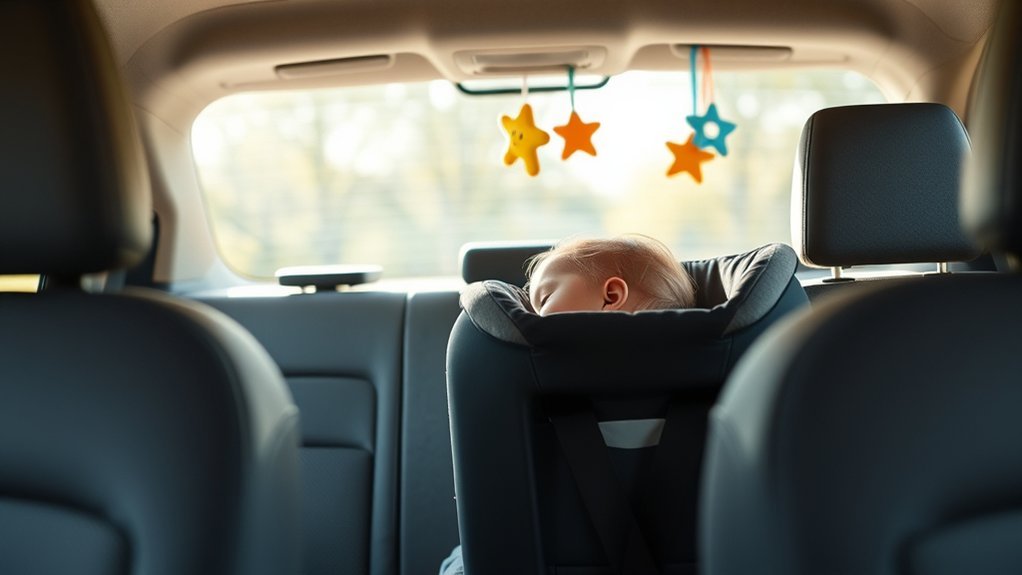When it comes to car seat sleep safety, knowing the do’s and don’ts is essential for your child’s well-being. You need to guarantee proper positioning and monitor their sleep to prevent any risks. While car seats can be convenient for napping, there are dangers associated with prolonged sleep in them. Understanding these guidelines can help protect your little one during travel. So, what are the key steps you should take?
Understanding the Risks of Sleeping in a Car Seat
While it may seem convenient to let your child nap in a car seat, understanding the risks involved is essential for their safety.
Car seats are designed for travel, not extended sleep, and prolonged use in a seated position can lead to serious health issues. Your child’s airway may become compromised, increasing the risk of suffocation or positional asphyxia.
Car seats are for travel, not sleep; prolonged use can compromise airways and increase suffocation risks.
Additionally, the lack of proper support can strain their developing spine, leading to discomfort or injury.
It’s important to recognize that infants sleep best in flat, safe surfaces, like cribs or bassinets.
Prioritizing your child’s sleep environment not only promotes their physical well-being but also empowers you as a parent to make informed choices that foster a safe and healthy sleep routine.
Proper Positioning for Safe Sleep
To guarantee your child sleeps safely, proper positioning is essential. Make certain your car seat is reclined at the correct angle to support your child’s head and neck. An upright position can lead to airway obstruction, so aim for a 30 to 45-degree recline.
| Positioning Aspect | Recommendation |
|---|---|
| Recline Angle | 30-45 degrees |
| Head Support | Use head supports if needed |
| Harness Adjustment | Snug but not restrictive |
| Check for Slouching | Monitor during travel |
Always check the manufacturer’s guidelines for your specific car seat model. Prioritizing correct positioning not only enhances comfort but also reduces the risk of accidents while making certain a safe sleeping environment for your child.
When to Use a Car Seat for Napping
Understanding when to use a car seat for napping is important for your child’s safety and comfort.
Ideally, you should use a car seat for napping only during car rides or when you’re traveling. It’s designed to keep your child safe in a moving vehicle, not as a regular sleeping space.
If your child falls asleep in the car seat after a journey, it’s best to transfer them to a flat, safe sleeping surface as soon as possible. Extended naps in a car seat can increase the risk of positional asphyxia.
Always prioritize a safe sleep environment, whether at home or on the go, to guarantee your child gets the rest they need without compromising their safety.
Alternatives to Car Seat Sleeping
When considering alternatives to car seat sleeping, it’s vital to prioritize your child’s safety and comfort. A crib or portable playpen provides a secure space for naps, allowing your child to rest flat on their back, which is important for preventing airway obstruction.
If you’re traveling, consider using a travel bassinet designed for infants, making sure it meets safety standards. For older children, a comfortable travel bed or a designated sleeping bag can offer a familiar sleeping environment.
Always verify these options are well-ventilated and on a stable surface. Remember, your goal is to create a safe and cozy sleeping space that fosters healthy sleep habits, empowering your child to rest soundly wherever you are.
Monitoring Your Child During Travel
Keeping an eye on your child during travel is just as important as guaranteeing they’ve a safe sleeping environment. Regularly glance in the rearview mirror to check on your little one. If possible, use a mirror designed for this purpose, allowing you to see them without taking your focus off the road.
Confirm they’re properly buckled and that the harness fits snugly. If your child appears uncomfortable, stop safely to adjust their position.
Limit distractions; avoid loud music or sudden movements that might wake them. Consider using a baby monitor for longer trips, giving you peace of mind.
Frequently Asked Questions
Can I Use a Car Seat for Overnight Sleeping?
No, you shouldn’t use a car seat for overnight sleeping. It’s designed for travel safety, not prolonged sleep. Instead, place your child in a crib or bassinet for a safer, more comfortable sleep environment.
Are There Specific Car Seat Models Recommended for Safe Sleeping?
There aren’t specific car seat models recommended for safe sleeping, as car seats are designed primarily for travel. Instead, consider using a crib or bassinet for safe overnight sleep. Always prioritize your child’s safety.
How Long Can a Baby Safely Sleep in a Car Seat?
You shouldn’t let your baby sleep in a car seat for more than two hours at a time. Prolonged sleeping can lead to unsafe positions, affecting their breathing and overall safety while traveling.
What Should I Do if My Child Falls Asleep in the Car Seat?
If your child falls asleep in the car seat, gently monitor them, ensuring their head isn’t slumped. When possible, carefully transfer them to a safe sleep surface. Every moment counts for their safety and comfort.
Are There Any Signs of Discomfort While Sleeping in a Car Seat?
Yes, signs of discomfort while sleeping in a car seat include squirming, fussing, or unusual head positioning. You’ll want to check for tight straps or awkward angles that might be causing your child distress.
Conclusion
In conclusion, keeping your child safe while they sleep in a car seat is essential. Think of it like steering through a winding road; proper precautions can prevent unexpected turns. Always verify the seat is at the right angle and monitor your child closely. Remember, car seats are for travel, not for extended napping. As soon as you can, transfer your little one to a flat, safe sleeping surface to promote better sleep and reduce risks.
